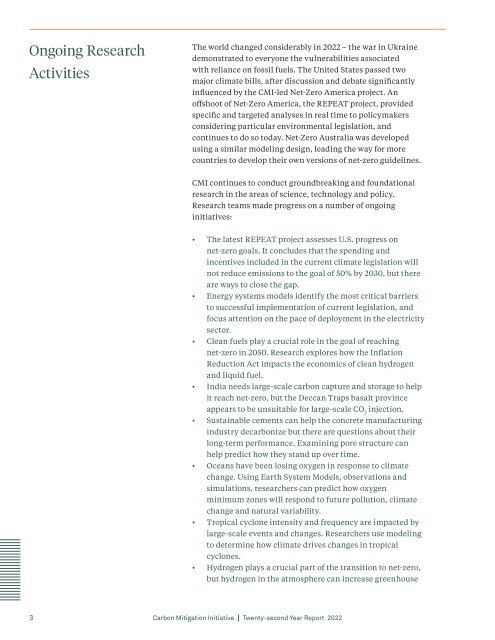CMI Annual Report 2022
Create successful ePaper yourself
Turn your PDF publications into a flip-book with our unique Google optimized e-Paper software.
Ongoing Research<br />
Activities<br />
The world changed considerably in <strong>2022</strong> – the war in Ukraine<br />
demonstrated to everyone the vulnerabilities associated<br />
with reliance on fossil fuels. The United States passed two<br />
major climate bills, after discussion and debate significantly<br />
influenced by the <strong>CMI</strong>-led Net-Zero America project. An<br />
offshoot of Net-Zero America, the REPEAT project, provided<br />
specific and targeted analyses in real time to policymakers<br />
considering particular environmental legislation, and<br />
continues to do so today. Net-Zero Australia was developed<br />
using a similar modeling design, leading the way for more<br />
countries to develop their own versions of net-zero guidelines.<br />
<strong>CMI</strong> continues to conduct groundbreaking and foundational<br />
research in the areas of science, technology and policy.<br />
Research teams made progress on a number of ongoing<br />
initiatives:<br />
• The latest REPEAT project assesses U.S. progress on<br />
net-zero goals. It concludes that the spending and<br />
incentives included in the current climate legislation will<br />
not reduce emissions to the goal of 50% by 2030, but there<br />
are ways to close the gap.<br />
• Energy systems models identify the most critical barriers<br />
to successful implementation of current legislation, and<br />
focus attention on the pace of deployment in the electricity<br />
sector.<br />
• Clean fuels play a crucial role in the goal of reaching<br />
net-zero in 2050. Research explores how the Inflation<br />
Reduction Act impacts the economics of clean hydrogen<br />
and liquid fuel.<br />
• India needs large-scale carbon capture and storage to help<br />
it reach net-zero, but the Deccan Traps basalt province<br />
appears to be unsuitable for large-scale CO 2<br />
injection.<br />
• Sustainable cements can help the concrete manufacturing<br />
industry decarbonize but there are questions about their<br />
long-term performance. Examining pore structure can<br />
help predict how they stand up over time.<br />
• Oceans have been losing oxygen in response to climate<br />
change. Using Earth System Models, observations and<br />
simulations, researchers can predict how oxygen<br />
minimum zones will respond to future pollution, climate<br />
change and natural variability.<br />
• Tropical cyclone intensity and frequency are impacted by<br />
large-scale events and changes. Researchers use modeling<br />
to determine how climate drives changes in tropical<br />
cyclones.<br />
• Hydrogen plays a crucial part of the transition to net-zero,<br />
but hydrogen in the atmosphere can increase greenhouse<br />
3<br />
Carbon Mitigation Initiative Twenty-second Year <strong>Report</strong> <strong>2022</strong>
















